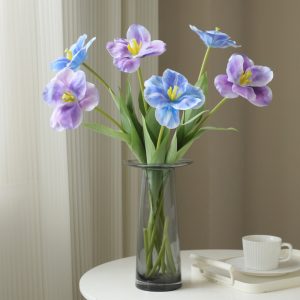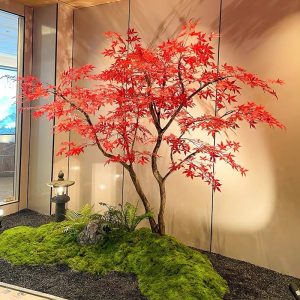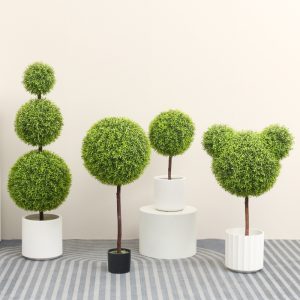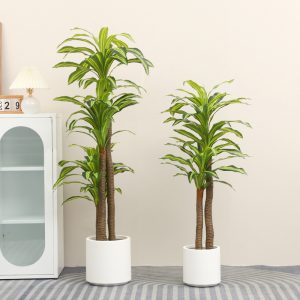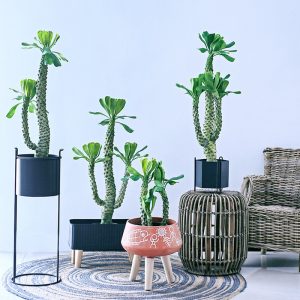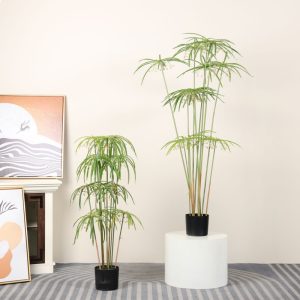On a Sunday morning, the sun in Oregon poured like melted honey through the white porch of Carly’s country cottage. I tightened my grip on the woven basket, my fingers slightly sweaty. It was my first visit to her new home, and on the phone, she had said, “There’s something here that will remind you of autumn meadows.”
The door creaked open, and Carly, wearing a caramel-colored knit sweater, had a dried daisy tucked into her hair. “Come in, I’ve just baked pumpkin bread,” she said. As she turned, I caught the sweet scent of cinnamon and butter mixed with a faint aroma of cedarwood, and a hint of “wildness” from the plants in the corner of the living room.
The hardwood floors in the entryway glistened warmly, with a pair of dirt-streaked leather boots beside a wrought-iron plant stand holding dried wheat stalks. The living room wasn’t very high-ceilinged, but the exposed wooden beams had a soft, light brown texture. A beige linen sofa was piled with deep green cushions embroidered with wheat patterns. Behind the sofa, a plant, about 1.8 meters tall, spread its leaves like a ray of autumn sunshine frozen in time.
It stood in a light gray concrete planter, with deliberately aged cracks around the rim, as if it had just been brought from the edge of a field. Dozens of stems of varying thickness wrapped in light brown faux straw, with leaves radiating outward in pale yellow and deep green, the topmost “fluff” was soft and puffy like clouds scattered by the wind. Sunlight filtered through the leaves, casting dappled spots of light on the floor.
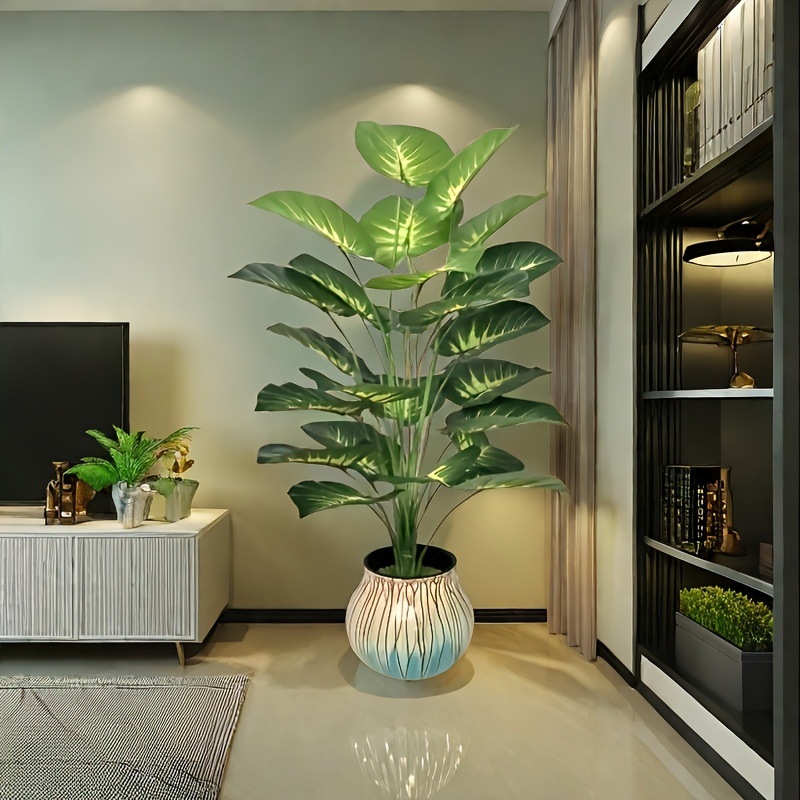
“Stunned?” Carly handed me a glass, condensation from the chilled apple cider dripping down the sides. It took me a moment to refocus, and my fingers gently brushed a leaf. The texture was rough yet resilient, and the vein patterns were as though sculpted by nature, even the edges of the leaf curled in a way that felt perfectly natural. “It’s faux cattail,” she said, surprising me—it was incredibly realistic.
“Is this really fake?” I leaned closer and noticed a few dry bundles of reed grass wrapped around the base of the stems, with pebbles scattered around, resembling a natural field scene. The breeze coming through the screen window caused the leaves to gently sway, making a rustling sound just like the real cattails I had seen at the farm last year.
Carly smiled from the sofa, her fingers tracing the embroidery on the cushion. “I used to grow real ones, remember? Last autumn, the fluff dropped all over the floor, and I spent three days cleaning it up with the vacuum.” I certainly remembered; she had sent me a photo of the “disaster scene” with the caption “Beautiful troubles.”
“But this one’s different.” She pointed to the fluffy top, “You see, it’s made with special fibers, so it doesn’t shed. It’s safe for homes with kids and pets.” The sunlight shifted to the west side of the plant, and the leaves gradually changed from pale yellow to golden brown, the layers of color rich and oil-painting-like. The best part was that some of the stems were purposely bent to create natural curves, as if they had been blown by the wind—much more wild-looking than neatly arranged real cattails.
“I originally wanted to buy real ones at the flower market,” Carly said, offering me a slice of pumpkin bread. “But the florist told me they only last about two months before wilting. In winter, they just die. Then, a friend recommended the fake ones—says they look great and are low-maintenance.” She pointed to the windowsill in the kitchen. “Look, I’ve got two small ones there, grouped together like a mini meadow.”
As she spoke, Carly’s son Tommy ran in, holding a football. He accidentally bumped into the planter. I almost spilled my drink, but the cattail plant only swayed gently—no leaves fell. “Look, it’s sturdy,” Carly laughed as she pulled her son away. “If they were real cattails, they’d be broken into pieces by now.”
Tommy pointed to the fluff on top: “Mom says this is magic grass that never wilts, even in winter.” I suddenly noticed a small drainage hole at the bottom of the planter. Carly read my thoughts and said, “It’s just for decoration. I spilled half a cup of water last week when watering the plants. I turned it over to drain and no water stains left.” She paused and added, “And it’s not afraid of the sun. I could put it on the balcony, and it wouldn’t fade. It’s way easier than real plants.”
Sitting on the wooden chair and sipping tea, my gaze couldn’t help but follow the shadows of the cattails. As the afternoon sun softened, their shadows danced on the white wall like a group of dancing sprites. I started imagining my own home—wasn’t that empty corner in my entryway perfect for a small fake cattail plant?
In the morning light, it could catch the steam from my milk cup; in the evening, the warm glow from my desk lamp would gild the fluff with golden edges. Even if I were away for three weeks, when I returned, it would still look just as vibrant, unlike the real reed on my windowsill, which always seemed to protest my neglect with wilted leaves.
“My husband always says I’m a plant killer,” I spun my teacup. “I’ve killed every plant I’ve had—green onions rot, succulents get overwatered, and even the so-called ‘hard-to-kill’ snake plant has died on me.” Carly handed me a cookie. “That’s why I recommend trying this. You don’t have to take care of it for six months, and even in a north-facing room, it won’t get leggy. It’ll always have that wild, natural look.”
As the sunset colored the sky with warm orange-pink hues, the fluff of the cattails seemed to be gilded. I noticed the “aging” details of the leaves—some had light brown “wilt spots,” and on the stems, there were tiny holes resembling insect damage. The artisans had perfectly replicated the worn beauty of natural plants, which was why even Tommy, who frequently visited the farm, hadn’t noticed a thing.
Tommy sat next to the planter, drawing with crayons, and some crayon shavings fell into the “soil.” Carly casually wiped it clean. “If it were real cattails, they’d be covered in fuzz by now,” she laughed. I looked at the cattail plant and suddenly understood its charm—it preserved the wild beauty of the plant while removing all the annoying little worries, like a silent guardian, quietly decorating life.
Before leaving, I stood at the entryway, putting on my shoes, and glanced back at the living room. The sunset stretched the shadows of the cattails long across the floor. Carly’s husband leaned against the fireplace, reading the newspaper, and the firelight flickered on the leaves, creating a warm and inviting scene that made me want to stay longer.
“I’ve decided,” I said, tying my shoes, my hands filled with excitement, “I’m going to find a few of these cattails for my house.” Carly smiled and handed me a note: “This shop has good quality, and you can choose different heights. Grouping them together adds dimension.”
The car’s heater hadn’t warmed up yet, but I was already planning where to place them. I’ll put a 1.5-meter one at each end of the dining table and place two shorter ones in the corners, bringing the feeling of an autumn meadow into the whole room. On weekend mornings, I can sit by the cattails, have breakfast, and watch the sunlight filter through the leaves and onto the linen tablecloth, just like at Carly’s house, surrounded by the natural wildness.
In the rearview mirror, the country cottage shrank in size, but the golden shadow of the cattails stayed clear in my mind.







